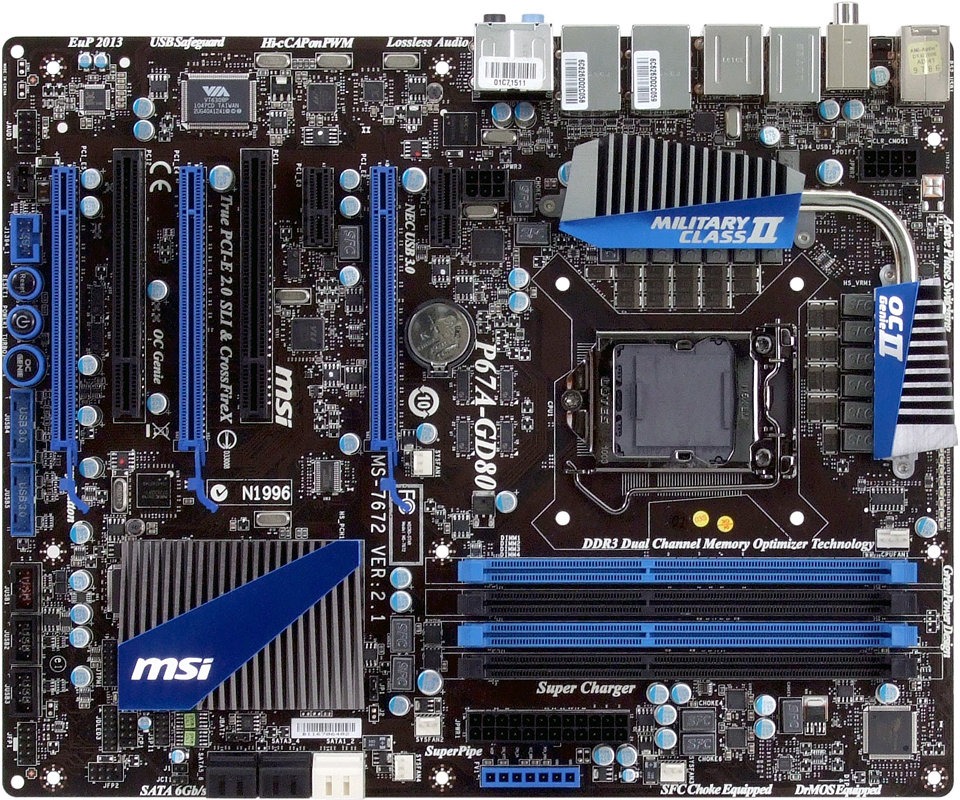High-End P67 Express: Five $200-250 Motherboards
With mainstream boards based on Intel's P67 Express chipset now priced well beyond $150, we reached into the $200-250 range to see what kinds of enhancements high-end buyers could expect just ahead of the anticipated Z68 Express launch.
MSI P67A-GD80
MSI’s P67A-GD80 has the same slot arrangement as every other board in today’s $200-250 P67 roundup, yet nearly everything else is at least somewhat different. For example, the P67A-GD80 has an incredible six I/O panel and four front-panel USB 3.0 headers.
MSI goes one-better than its competitors in the eSATA department by adding RAID support via Marvell’s 9128 SATA 6Gb/s controller. Conspicuously missing, however, are any third-party internal port controllers, as MSI figured out that even enthusiasts rarely use more than six internal drives.
Less conspicuous is the lack of any PCIe-expanding bridge. The P67A-GD80 has the same limitations as Asus’ P8P67 EVO, where enabling x4 mode on its third x16 slot disables front-panel USB 3.0, eSATA, and the PCIe-to-PCI bridge. Not mentioned in MSI’s documentation is that its FireWire controller is also PCI-based, so disabling the PCIe-to-PCI bridge means losing FireWire.
The GD80’s second PCIe x1 slot shares a single lane with the top PCIe x1 slot, so builders can only use one of these at a time. As we said of the competing Asus model, a layout with fewer compromises would have eliminated the second x1 slot altogether, since it’s always tied to another slot (unusable) and blocked by the graphics coolers of most performance-oriented graphics cards anyway (inaccessible).
With those marks against it, we might not have even bothered to mention that the remaining USB 3.0 ports all share a single 5 Gb/s PCIe lane through a single NEC D720200F1 controller and VIA Labs VL810 hub, except that this restriction stands even when the last graphics slot is empty.
The P67A-GD80 includes a mid-market installation kit with four SATA cables, a slot adapter for two of its front-panel USB 3.0 ports, and a flexible SLI bridge. MSI adds some quick connectors to help builders bundle the ends of loose front-panel cables, along with four probe wires for its voltage check-point feature.
Get Tom's Hardware's best news and in-depth reviews, straight to your inbox.
-
joytech22 So glad I grabbed my P8P67 Deluxe!Reply
It had all the features I was looking for at a low enough price to make it very appealing. -
Crashman rolli59Nice article would have been nice to have a Gigabyte board in there as well.Please tell Gigabyte to produce something for this market!Reply
Tom's Hardware included the UD4 in its $150-200 motherboard roundup, and the UD5 costs more than $250. -
Manos How te hell is it possible that a website like this keeps ignoring my question as in WHY its been for so many months if not year or whatever, that they dont fix this *** and I cant click to submit my comment from IE? How can THIS be the only website with issues with IE? I find it rather sad. Its why i quit commenting instead of being forced to open a different browser for this site which I used to love and respect. Till they started ignoring this issue Ive been pointing out ( and not just me ).Reply
Thank you for the charts tho id love to see one with Maximus IV included x.x ( I edited cause I asked something stupid as in why I dont see it in the chart. Sorry.. Been working all night and no time to read the article. Bits only.And no I obviously hadnt read the title x.x My bad. Happy Easter! -
jerreddredd It would have been nice to see if there is a performance gain in these "high end" boards over a value P67 board.Reply
For an even better article also throw in one of each value rated H67 and H61 boards. ($240 vs $130 vs $70 boards)
-
alidan jerreddreddIt would have been nice to see if there is a performance gain in these "high end" boards over a value P67 board. For an even better article also throw in one of each value rated H67 and H61 boards. ($240 vs $130 vs $70 boards)this, i would love to see how the high end stacks up with the low end. the low may not have as much as the high end, but performance is really all that matters considering we can just get expansion cards for things we dont have.Reply -
Hupiscratch Great article. Now it´s time for the high-end overclocking oriented boards, like the ASUS Maximus IV Extreme.Reply -
memadmax I'm gonna go all out on this chipset when it matures a bit. A cool 5 grand i'm thinking for my next gen build.Reply



